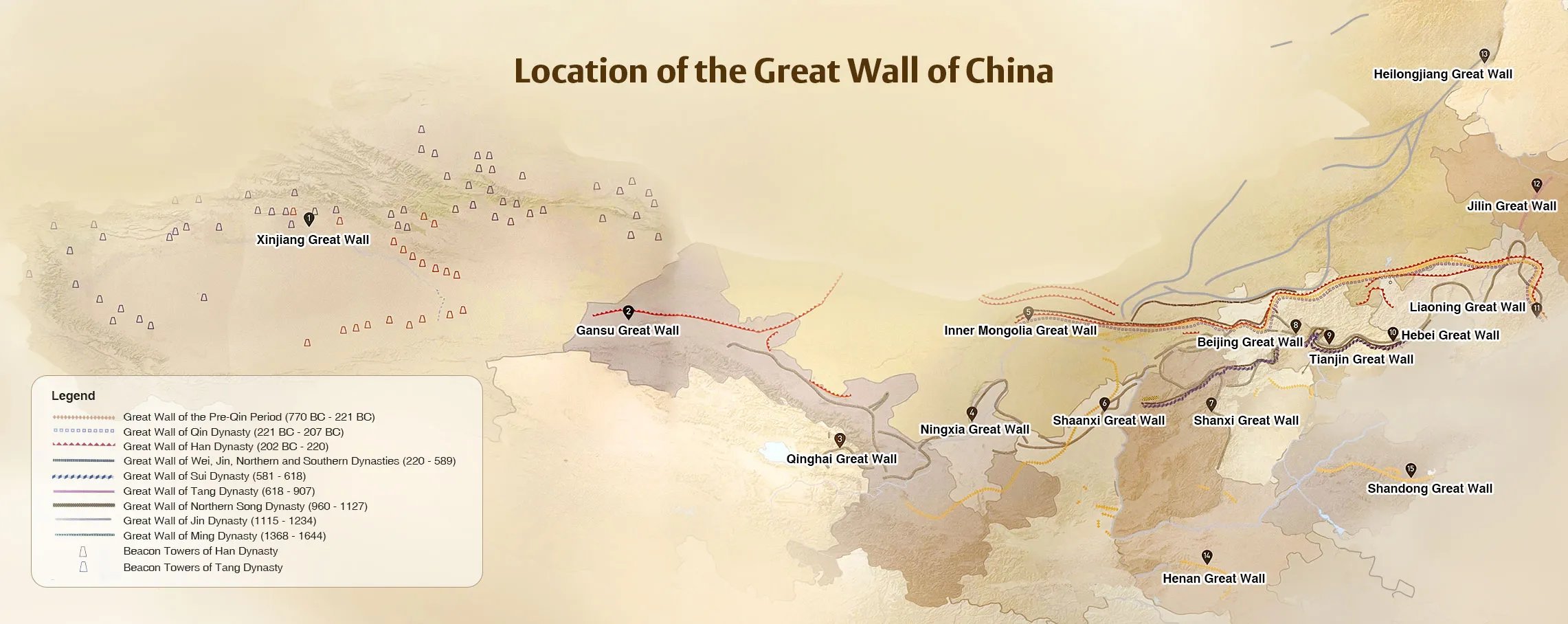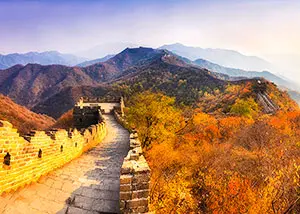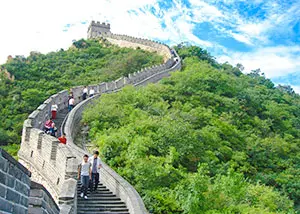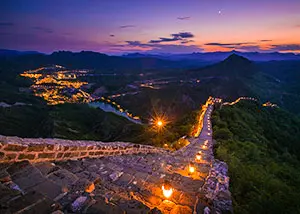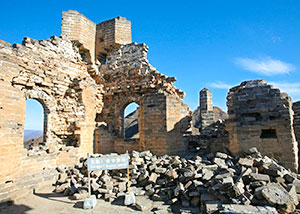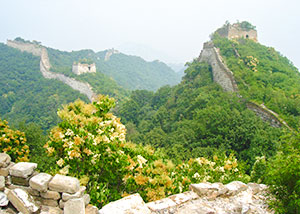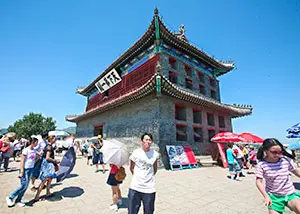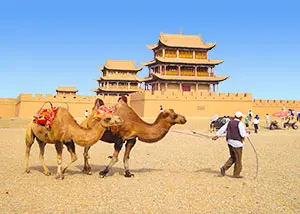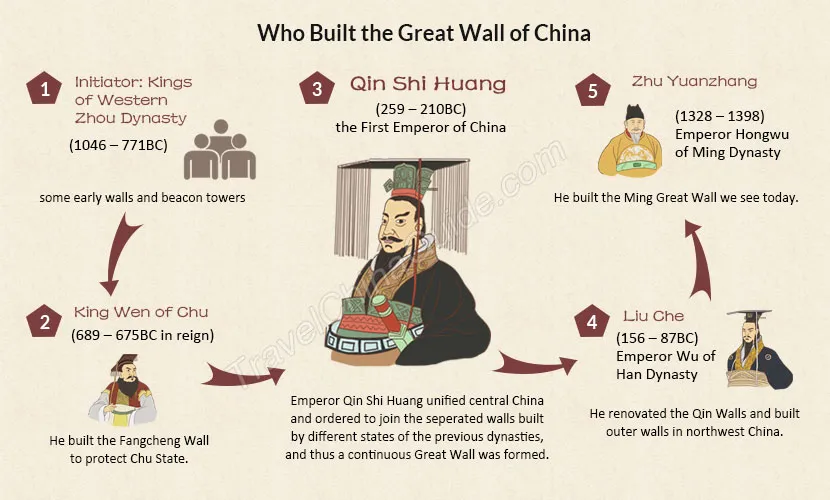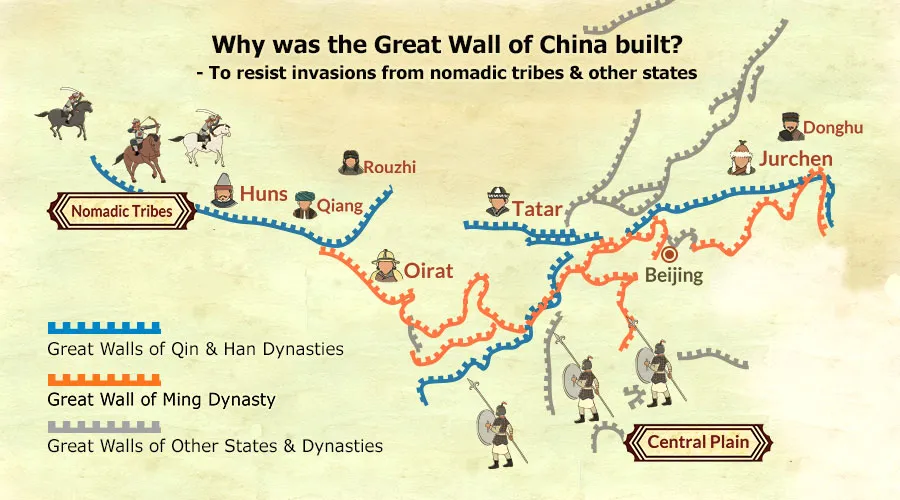Home /
Great Wall of China
Chinese Names: 长城cháng chéng / 万里长城wàn lǐ cháng chéng
Literal Meaning: The Long Wall
Location: North China
Length: 21,196.18 kilometers (13,170.70 miles)
History: 2,700 years old
Construction Time: 2,500 years, from the Spring and Autumn Period (770 – 476BC) to 1878 in late Qing Dynasty (1644 – 1911)
 Read More:
Read More:
25 Fun Facts about Great Wall
Where is the Great Wall of China?
How long is the Great Wall of China?
How tall is it?
How wide is it?
Can it be seen from the space?
Great Wall FAQs
Literal Meaning: The Long Wall
Location: North China
Length: 21,196.18 kilometers (13,170.70 miles)
History: 2,700 years old
Construction Time: 2,500 years, from the Spring and Autumn Period (770 – 476BC) to 1878 in late Qing Dynasty (1644 – 1911)
25 Fun Facts about Great Wall
Where is the Great Wall of China?
How long is the Great Wall of China?
How tall is it?
How wide is it?
Can it be seen from the space?
Great Wall FAQs
Renowned as a UNESCO World Heritage site since 1987 and one of the Seven Wonders of the Medieval World, the Great Wall of China is not just 'medieval'. Early in the 7th century BC, several ancient states built their own boundary walls, which were later connected by Qin Shi Huang (259 – 210BC), the First Emperor of China, and known as the '10,000-li Long Wall'. In the following 2,000 years, many dynasties continued to consolidate and extend the Great Wall, for not only defense, but also border trade management, imposing tariffs, and immigration control.
The Great Wall's military use faded away, but now as an unparalleled architectural feat with historical significance, it is certainly the No. 1 iconic attraction in China. There are wall remains found in 15 provinces of China. The well-preserved sections we see today were mainly built during the Ming Dynasty (1368 – 1644), among which the most popular are around Beijing, including Badaling, Mutianyu, Juyongguan, and Simatai. A day tour or a long hike along the Great Wall allows you to travel back in time to feel the thousands of years’ vicissitudes and the ethos of the ancient Kingdom of China.
Where is the Great Wall of China located?
- Location: north China, East Asia
- Total Length: 21,196.18 kilometers (13,170.70 miles), half of the length of the equator
- Length of Ming Great Wall: 8,851.8 kilometers (5,500.3 miles)
- West End: the First Fire Tower of the Great Wall, in Jiayuguan of Gansu
- East End: Hushan Great Wall, in Dandong of Liaoning
- Course & Coverage: 15 provinces and regions, roughly from east to west – Heilongjiang, Jilin, Liaoning, Hebei, Beijing, Tianjin, Shandong, Henan, Shanxi, Shaanxi, Inner Mongolia, Ningxia, Gansu, Qinghai, Xinjiang.
Which Section of Great Wall to Visit
The official survey by the National Cultural Heritage Administration of China reveals that Inner Mongolia, Hebei, and Shanxi are the top three regions boasting the most Great Wall relics. The walls, crossing 26 degrees of longitude, and not machine-made, appear in totally diversified status and sceneries. Generally the walls in east China are kept in good condition, while those in the wild northwest have been heavily weathered or damaged.
Beijing, owning only 5.38% of all the wall relics throughout China, has the quintessence of the Ming Great Wall. The best-preserved and most-visited sections are generally within 130 km north of downtown Beijing.
List of All Great Wall Sections
Beijing, owning only 5.38% of all the wall relics throughout China, has the quintessence of the Ming Great Wall. The best-preserved and most-visited sections are generally within 130 km north of downtown Beijing.
- First-time visitors to Beijing: Badaling, or Mutianyu
- Return visitors: Juyongguan, or Simatai (with Gubei Water Town)
- Experienced hikers: Jiankou (wild and dangerous)
- Best sections out of Beijing: Shanhaiguan in Hebei, Jiayuguan in Gansu, Zhenbeitai in Shaanxi
Read more:
Top 10 Great Wall Sections to VisitList of All Great Wall Sections
Great Wall in History: Who, When, and Why Built it?
- The rulers of more than 20 ancient dynasties and states had built on a large scale their sections of the Great Wall. The soldiers, common people and prisoners constituted the major labor force.
1. Initiator: Kings of Western Zhou Dynasty (1046 – 771BC)
There is not enough proof to confirm who was the first king to start to build the Great Wall, but at least there were some walls and beacon towers before the end of the Western Zhou. The earliest record regarding the walls is the story of King You of Zhou (795 – 771BC) who abused the war beacons and fooled the vassals, just to amuse his favorite queen.
2. King Wen of Chu (689 – 675BC in reign)
From 688 to 678BC, the King Wen ordered the building of the Fangcheng Wall to protect Chu State. Later on, a number of states built their own walls.
3. Qin Shi Huang (259 – 210BC): the First Emperor of China
This is the most well-known historical figure to be widely considered the initiator of the Great Wall. He’s not the real initiator, but he did make a remarkable contribution in joining the seperated walls built by different states of the previous dynasties after he unified central China, and thus a continuous Great Wall was formed.
4. Liu Che (156 – 87BC): Emperor Wu of Han Dynasty
The emperor ordered renovaion of the Qin Great Wall and he built outer walls in further northwest China, completing the Great Wall at its longest in history – an amazing 10,000 kilometers!
5. Zhu Yuanzhang (1328 – 1398): Emperor Hongwu of Ming Dynasty
He started the last climax of Great Wall constrction in ancient Chinese history, and his descendants continued the construction for 130 years, generally giving the wall its present appearance.
Read more:Who built the Great Wall of China?
How to Tour the Great Wall of China
--
spring and autumn, from March to October• Best Sections – Badaling & Mutianyu in Beijing
Badaling’s popularity leads to overcrowding at peak holiday times, so you are recommended to visit Mutianyu during weekends or big holidays, as this allows a more comfortable travel experience for you to enjoy the magnificent beauty of the Great Wall. Try the exciting toboggan down the Great Wall if you like.
People who have been to these two sections can choose from Juyongguan, Jinshanling, Gubeikou, and Simatai around Beijing.
• Clothing & Backpack
• How to Plan a Day Tour to the Great Wall
10:00 – 13:00 2 to 3 hours’ hiking on the Great Wall; cable car is available.
13:00 – 14:00 Have lunch in a local fast food restaurant at the foot of the wall.
14:00 – 16:00 Return trip: bus 877 from Badaling; bus h23 from Mutianyu, and transfer to bus 916 Express.
* You can add another attraction in this day according to your own pace. The Forbidden City and Temple of Heaven in downtown Beijing, and Ming Tombs near Badaling are good choices.
Read more:
How to Visit the Great Wall - Plan a Perfect Day TripHow to Get to the Great Wall from Beijing
How much does it cost to visit the Great Wall?
10 Insider Tips for Great Wall Travel - Dos and Don’ts
Book with Us:
See more Great Wall Tours
Great Wall Hiking: Adventure for the Brave
The Great Wall of China has long been the dream of hikers all over the world. What would it feel to walk the whole length of the Great Wall? William Edgar Geil, an American traveler and geographer and the first to hike the entire Great Wall in 1908, answered this question in his books and pictures. Dong Yaohui, a famous Great Wall expert, together with his two friends, hiked 7,400 km west from Shanhaiguan to Jiayuguan in 508 days from 1984 to 1985, becoming the first Chinese to finish walking the entire length of the Great Wall. “It was like a non-stop challenge of uphill and downhill, summer heat and winter chill, and exhausting long-distance walking," Dong recalled, “The Great Wall is alive, not cold and dull. When you put your palm on the wall, you are shaking hands with Chinese ancestors.” This long hike greatly enhanced Great Wall’s international visibility, and the wall was listed as a World Heritage site two years later in 1987. Since then, several Chinese and foreign hikers and explorers succeeded in walking the full length of the wall, leaving many fascinating stories.
How to Hike the Full Length of the Great Wall of China? 8,851.8 km!
Has anyone walked the Great Wall of China? – William Edgar Geil in 1908, Dong Yaohui in 1985, Liu Yutian in 1986, William Lindsay in 1987, Stephen Robert Loken in 2011…
Hikers prefer the ruins of dilapidated walls to the restored Great Wall. Walking the entire Great Wall is not an easy thing, but short hikes along some wild sections are popular. The Great Wall in Beijing totals 573 km (356 mi), including only 40 km being well repaired, while more than 500 km in wild and primitive condition. Jiankou, Simatai, Huanghuacheng, Jinshanling, Hefangkou, and Gubeikou are popular sections full of wild fun but dangerous and physically demanding. For people without hiking experience, the wild walls are not recommended. Choose an average route and join a hiking group with a professional leader if you are interested. For experienced hikers, make sure to find partners, choose the right season and best time, study the route carefully in advance, and make full preparations. Always tell relatives or friends where you intend to go and say when you expect to complete your journey.
Great Wall Hiking Checklist: 15 Things that Expert Hikers Always Take
How to Camp on the Great Wall
Read more:
How Long to Walk the Great Wall of ChinaHow to Hike the Full Length of the Great Wall of China? 8,851.8 km!
Has anyone walked the Great Wall of China? – William Edgar Geil in 1908, Dong Yaohui in 1985, Liu Yutian in 1986, William Lindsay in 1987, Stephen Robert Loken in 2011…
Hikers prefer the ruins of dilapidated walls to the restored Great Wall. Walking the entire Great Wall is not an easy thing, but short hikes along some wild sections are popular. The Great Wall in Beijing totals 573 km (356 mi), including only 40 km being well repaired, while more than 500 km in wild and primitive condition. Jiankou, Simatai, Huanghuacheng, Jinshanling, Hefangkou, and Gubeikou are popular sections full of wild fun but dangerous and physically demanding. For people without hiking experience, the wild walls are not recommended. Choose an average route and join a hiking group with a professional leader if you are interested. For experienced hikers, make sure to find partners, choose the right season and best time, study the route carefully in advance, and make full preparations. Always tell relatives or friends where you intend to go and say when you expect to complete your journey.
Read more:
Best Great Wall Hike: Top 5 Wild Hiking RoutesGreat Wall Hiking Checklist: 15 Things that Expert Hikers Always Take
How to Camp on the Great Wall
Condition and Protection: Great Wall is in Danger!
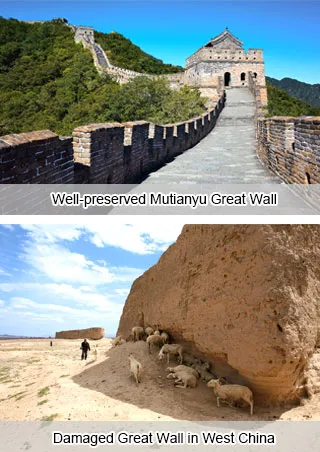 The Great Wall of China is on the list of 100 endangerd sites issued by the World Monuments Fund. The renovated walls open as tourist sites can not stand for the whole wall. In fact, less than 10% of the wall is visible to ordinary tourists. The real majority, more than 90%, are crumbling walls snaking between the mountains, undeveloped and poorly protected.
The Great Wall of China is on the list of 100 endangerd sites issued by the World Monuments Fund. The renovated walls open as tourist sites can not stand for the whole wall. In fact, less than 10% of the wall is visible to ordinary tourists. The real majority, more than 90%, are crumbling walls snaking between the mountains, undeveloped and poorly protected.The length of the walls built by different dynasties totaled 50,000 km, while the existing Great Wall is 21,196 km, according to the National Cultural Heritage Administration of China. That means, half of the walls has disappeared in the course of history.
What’s more serious is that the current number of 21,196 km is not constant. Instead, it keeps reducing! 30% of the Great Wall is disappearing at an alarming rate, mainly for two reasons. One is natural weathering. For thousands of years, the Great Wall has endured the ravages of the gobi desert. Plants growing into some walls accelerate its decay. Some walls and watchtowers are tumbledown, likely to be destroyed by just a storm. Another is reckless human behavior. Before 2000, people in remote areas, lacking the awareness to protect the Great Wall, knocked down bricks to sell, stole them to build houses, or even dug holes in the walls to raise livestock. Even in recent years, someone still pulled down the walls for profits. A shocking case was that in Xinxiang of Henan Province, the 2,300-year-old Zhao Great Wall has been severely damaged for mining and 2,155 meters (2,357 yards) of it has disappeared forever in the past over 10 years from 2012 to 2023.
Substantial measures to protect the Great Wall began in the 1980s, and until 2006, the State Council of China promulgated the Regulation on the Protection of Great Wall, effectively strengthening the conservation of the walls, forts, passes, and beacon towers, and standardizing the development and utilization of the Great Wall. However, are you aware now? Regulations can only regulate some human activities, while someone still damage the walls illegally, let along inevitable weathering for walls exposed to the vast natural environment. We will do our best to make it stand longer, but hurry up to go and see it before it disappears!
Read more:
Current Situation of Great WallRegulation on the Protection of Great Wall
Great Wall Protection Stories and Reports
- Our Tour Group on Badaling
- Our Guests in Beijing
- Our Group on Badaling
 6-Day Small Group Tour to Beijing/ Xi'an from $929
6-Day Small Group Tour to Beijing/ Xi'an from $929
- Last updated on Jun. 10, 2024 by Brenda Lian -
Questions & Answers on China Great Wall
Asked by Shelagh from CANADA | Jul. 15, 2024 13:26 Reply
Reply
Tourism bus from Beijing to Gubeikou Water Town
Do I need to buy tickets in advance for the tourism bus to Gubeikou Water Town that departs at 9 am from Donzhimenwai bus stop or can I just go to the bus stop and buy my tickets on the bus. If I need to buy them in advance, how is the best way to do this?
Answers (1)
Answered by Keith | Jul. 16, 2024 01:13 0
0 0
0 Reply
Reply
You can buy the ticket on the site upon arrival and I heard that passengers need to pay in cash or download 亿通行 APP to make the payment. Or you can take a train from Beijing North to Gubeikou Railway Station and then take a shuttle bus there to the water town.
Asked by Zoe from NEW ZEALAND | Jun. 08, 2024 11:56 Reply
Reply
Landing in Shanghai and flying out of Shanghai. Can we visit Beijing?
Hello we land in Shanghai and fly out of Shanghai 2 days later. Can we visit Beijing and the Great Wall while on the 72hr visa?
Answers (1)
Answered by Emily | Jun. 10, 2024 23:01 0
0 0
0 Reply
Reply
Sorry, you can't. Beijing and Shanghai are in two transit areas.
Asked by eric from UK | May. 28, 2024 04:12 Reply
Reply
Where to get close up to the original construction of the Great Wall at a low level.
What is the elevation of Jiayuguan City and can you see the unreconstructed remains of the original wall from there? I know the maximum height of the fort and it is too high for us oldies with health problems.
If it cannot be seen from the city, can anyone suggest where along the wall it can be seen at a lower level? We will be based in Zhengzhou city.
If it cannot be seen from the city, can anyone suggest where along the wall it can be seen at a lower level? We will be based in Zhengzhou city.
Answers (1)
Answered by Lori | May. 28, 2024 19:54 0
0 0
0 Reply
Reply
There are two sections of primitive walls on the southwest and northwest of the Inner City of Jiayuyuan and the altitude is about 1,600m (5,250 ft).
Actually, I recommend you to visit these sections in Beijing, where the altitude is much lower and many are equipped with cable cars for easier climbing.
Actually, I recommend you to visit these sections in Beijing, where the altitude is much lower and many are equipped with cable cars for easier climbing.
Asked by ivy leung from HONG KONG | May. 15, 2024 20:06 Reply
Reply
Is Huangyaguan open to public during the marathon?
I want to visit the section of Huangyaguan on the day of the Great Wall Marathon this Sat. Will I be allowed into Yin Yang Square as a tourist?
Answers (3)
Answered by Lori | May. 20, 2024 18:19 0
0 0
0 Reply
Reply
No, you were not allowed.
Answered by Ivy Leung | May. 21, 2024 22:25 0
0 0
0 Reply
Reply
Actually I was but some sections of the wall were closed. Most were open though.
Answered by Leo | May. 22, 2024 20:34 0
0 0
0 Reply
Reply
Dear Ivy Leung, thanks for your feedback and it will for sure help future visitors. Very appreciate!
Asked by Eva Paparisteidou from GREECE | May. 02, 2024 15:41 Reply
Reply
Arent there any relics of the Qin Great Wall in Gansu?
Answers (4)
Answered by Rita | May. 05, 2024 23:55 0
0 0
0 Reply
Reply
Yes, there are some. Minxian County in Dingxi City of Gansu has some of the wall relics from the Qin Dynasty.
Answered by Greece | May. 31, 2024 03:56 0
0 0
0 Reply
Reply
Thank you. I haven’t seen any photos. Are they worth visiting?
Answered by Emily | Jun. 03, 2024 01:50 0
0 0
0 Reply
Reply
The Qin Great Wall in Minxian and Dingxi is not famous and popular. The most popular great wall in Gansu is the Overhanging Great Wall in Jiayuguan built in Ming Dynasty which is definitely worth visiting.
Answered by Rita | Jun. 03, 2024 18:12 0
0 0
0 Reply
Reply
Hi Eva Paparisteidou, the most visiting worthy sections are those in Beijing, like Badaling and Mutianyu. They are far more grand.




